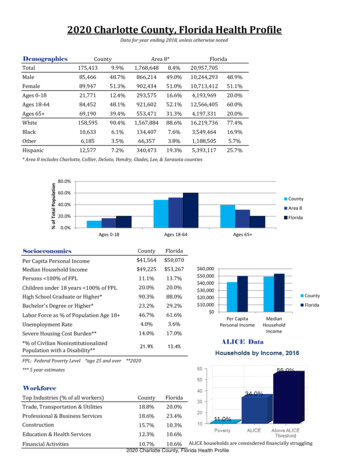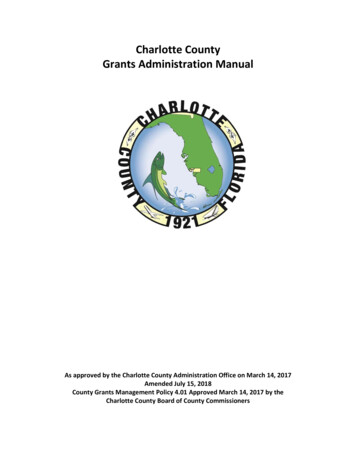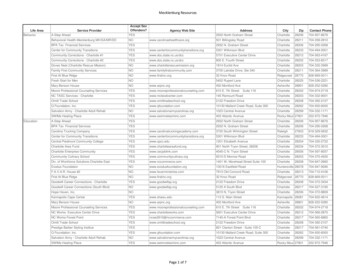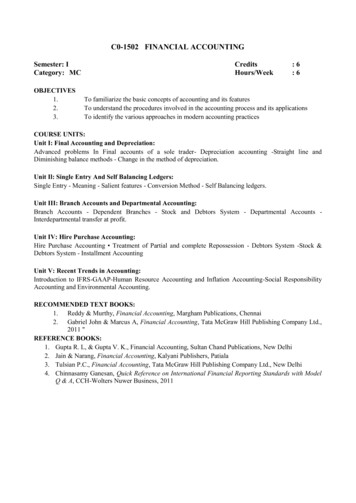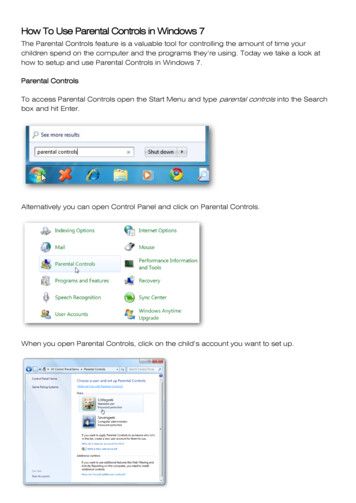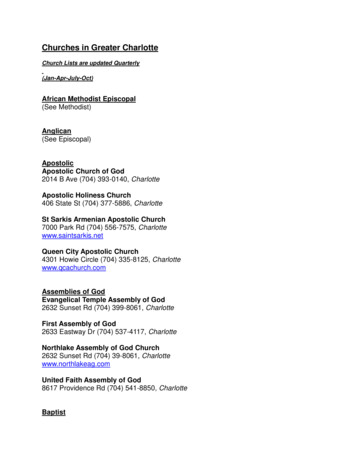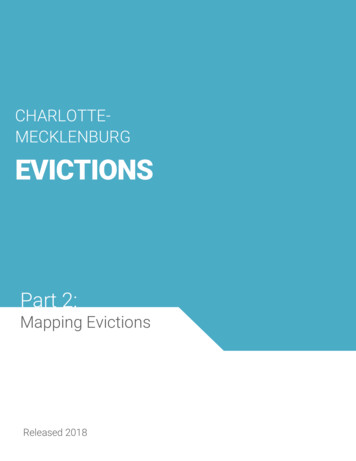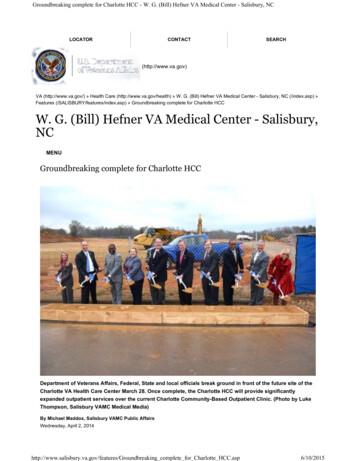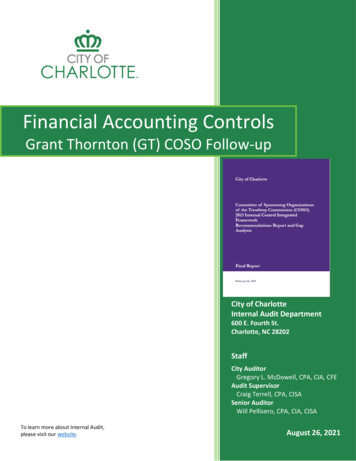
Transcription
Financial Accounting ControlsGrant Thornton (GT) COSO Follow-upCity of CharlotteInternal Audit Department600 E. Fourth St.Charlotte, NC 28202StaffCity AuditorGregory L. McDowell, CPA, CIA, CFEAudit SupervisorCraig Terrell, CPA, CISASenior AuditorWill Pellisero, CPA, CIA, CISATo learn more about Internal Audit,please visit our website.August 26, 2021
Financial Accounting Controls AuditGrant Thornton (GT) COSO Follow-upExecutive SummaryObjectiveConclusionThis audit was conductedto determine whethersatisfactory progress hasbeen made in achievingthe key recommendationsmade in Grant Thornton’sreview of the City’sinternal controls.Limited progress has been made to address Grant Thornton’s most criticalrecommendations, which can significantly improve City-wide financialaccounting internal controls.Mandatory Vacations Audit Executive SummaryBackgroundIn February 2018, GrantThornton LLP (GrantThornton) presented agap analysis using the2013 COSO InternalControls IntegratedFramework. One of thereport’s key takeawayswas “ the City ofCharlotte’s controlenvironment could beimproved and enhancedby following the COSOFramework as a bestpractice.”The COSO Frameworkconsists of 17 principlesthat fall under fivecomponents. Using thisFramework, GrantThornton recommendedactions the City shouldtake to strengtheninternal controls.Auditors identified ninekey recommendations forinclusion in this audit’sscope.HighlightsThe City has not fully implemented seven of the nine most criticalrecommendations from GT’s COSO Gap Analysis report. Identify Structure, Authority, and Responsibilities of theInternal Control ProgramConduct an ERP System Post-Implementation ReviewDevelop a Code of Conduct and Ethics TrainingConduct Internal Control Process Improvement DeepDives of Business ProcessesDevelop and Hold Internal Control TrainingPerform an Enterprise Risk Management (ERM) RiskAssessmentDetermine Monitoring ActivitiesContinue and Sophisticate the ERM PilotDocument IT System Controls in the System SecurityDocumentActions Taken and PlannedFinance has recently established a new Financial Internal Controls Division.While the focus of the new division will be documenting controls relatingto financial reporting using the COSO framework, the group will also be aresource for other departments. Finance notes that progress towardaddressing these critical items, which will significantly improve citywidefinancial internal control, had been previously constrained by limited staffavailable to successfully design and implement a COSO compliant citywideinternal control program.HR is reviewing the Allegations of Employee Misconduct Policy todetermine if it needs updating. All City employees will be required tocomplete annual ethics training, starting in October 2021.
Financial Accounting Controls Audit – GT COSO Follow-upAugust 26, 2021Page 2ContentsHighlights . 1Background . 3Objective. 3Scope, Methodology, and Compliance . 4Finding and Recommendations . 5The City has not fully implemented seven of the nine most critical recommendationsfrom GT’s COSO Gap Analysis report. . 5Conclusion . 12Distribution of Report . 12Appendix. 13
Financial Accounting Controls Audit – GT COSO Follow-upAugust 26, 2021Page 3BackgroundIn February 2018, Grant Thornton conducted a gap analysis using the 2013 COSO InternalControls Integrated Framework under a contract with the Finance Department (Finance) and theCity Manager’s Office (CMO). One of Grant Thornton’s key takeaways was “ the City ofCharlotte’s control environment could be improved and enhanced by following the COSOFramework as a best practice.”The COSO Framework consists of 17 principles that fall under five components: Control EnvironmentRisk AssessmentControl Activities Information & CommunicationMonitoring ActivitiesGrant Thornton, using the COSO Framework, recommended actions that the City should take tostrengthen internal controls. In its February 2018 report, Grant Thornton suggested these beimplemented in a phased approach so that more important improvements could be prioritized.The report included recommended actions grouped by COSO component (Appendix).ObjectiveThis audit was conducted to determine whether satisfactory progress has been made in achievingthe key recommendations made in the 2018 Grant Thornton report that reviewed the City’sinternal controls according to the COSO 2013 Integrated Framework.
Financial Accounting Controls Audit – GT COSO Follow-upAugust 26, 2021Page 4Scope, Methodology, and ComplianceScopeAuditors identified the following nine key recommendations from the original Grant Thorntonreview:1.2.3.4.5.6.7.8.9.Develop a Code of Ethics and ethics training;Develop and hold internal control training;Conduct an ERP system post-implementation review;Identify structure, authority, and responsibilities of the internal control program;Continue and sophisticate the ERM pilot;Perform an ERM risk assessment;Conduct internal control process improvement deep-dives of business processes;Document IT system controls in the system security document; andDetermine monitoring activities.MethodologyTo achieve the audit objectives, auditors performed the following: Judgmentally selected the recommendations from the Grant Thornton report deemedcritical for improvements to the City’s internal control environment,Interviewed department staff, andReviewed relevant documentation.ComplianceWe conducted this performance audit in accordance with generally accepted governmentauditing standards. Those standards require that we plan and perform the audit to obtainsufficient, appropriate evidence to provide a reasonable basis for our findings and conclusionsbased on our audit objectives. We believe that the evidence obtained provides a reasonablebasis for our findings and conclusions based on our audit objectives.
Financial Accounting Controls Audit – GT COSO Follow-upAugust 26, 2021Page 5Finding and RecommendationsThe City has not fully implemented seven of the nine most criticalrecommendations from GT’s COSO Gap Analysis report.The following provides an implementation status of each key recommendation:1.Develop a Code of Conduct and Ethics TrainingPer Grant Thornton report: Develop a Code of Conduct to guide employees in ethicalbehavior, activities, and decisions. Management should ensure the Code of Conduct isregularly communicated and reinforced to all levels of the organization. Establish continualand periodic compliance procedures to confirm that expectations and requirements arebeing met. A Code of Conduct provides the basis for evaluating adherence to integrity andethical values across the organization. Additionally, requiring staff to take ethics trainingensures that staff are continuously aware of expectations.The City has published a Code of Ethics on CNet, however, it is not a formal City policy.There is a policy titled “Allegations of Employee Misconduct” that does not appear to havebeen updated since its issuance in 1982. This policy is not published on CNet.As reported in the Conflict of Interest Investigation audit report (issued October 28, 2020),the Code of Ethics training module exists on the City’s Learning Management System andHuman Resources (HR) has made the training a requirement for all new hires. The revisedConflict of Interest policy is currently pending review and approval and will be added to theeLearning platform when finalized.Recommendation A: HR should update the Allegations of Employee Misconduct Policy(from 1982) and consider incorporating the current Code of Ethics as a part of this policy.Value Added: Compliance; Risk ReductionHR Response: A decision has not been formalized by HR to combine the Code of Ethics and theAllegations of Employee Misconduct; however, HR is reviewing this policy to determine the need toupdate.Recommendation B: The CMO and HR should require all employees to annually complete aCity ethics course.Value Added: Compliance; Risk ReductionHR Response: HR currently requires all new hires and employees participating in the city’sSupervisor Training, to complete the Ethics Training module. HR will begin requiring all currentemployees to complete the Ethics Training each year in October 2021. This training will exist as aneLearning module in our current LMS (Learning Management System) and for those employees thatexperience challenges with access to the eLearning module, it will be available in a paper format fortheir review and signature.
Financial Accounting Controls Audit – GT COSO Follow-upAugust 26, 2021Page 62.Identify Structure, Authority, and Responsibilities of the Internal Control ProgramPer Grant Thornton report: An Internal Control Program is vital to the functioning of anyorganization so that management has reasonable assurance regarding the achievement ofan entity’s objectives. The internal control infrastructure is the foundation of an InternalControl Program.The framework would include the structure, authority, andresponsibilities for documenting, updating, and testing internal controls across theorganization.In 2018, Finance created a team to review various internal controls/processes throughoutthe City. Finance has a formal charter in place for the Internal Control Team that adequatelyoutlines their scope of work and their objectives. This Internal Control Team consisted ofcurrent Finance Department staff who performed this work on a part-time basis, in additionto their regular job responsibilities. Several members of this team were unable to assistduring parts of the year as they were needed to compile the City’s annual report.Action Taken: Finance has created a Financial Internal Controls Division (and recently hireda Division Manager). Several positions from within Finance will be migrated to this newdivision. This division will be able to better focus their time towards the responsibilitiespreviously performed by the ad-hoc Internal Control Team. The structure, authority andresponsibilities of the new division will evolve over time.3.Conduct Internal Control Process Improvement Deep-Dives of Business ProcessesPer Grant Thornton report: Begin to conduct internal controls process improvement deepdive assessments of selected business processes. This would involve walkthroughs of eachprocess with stakeholders, reviewing any job aids and procedures, inventorying currentcontrols and attributes, providing as-is flow charts and assessment of the controlenvironment and activities, and providing recommendations of changes to remove or addadditional controls so that all financial statement assertions are covered.The Finance Internal Control Team (outlined in the preceding section) performs the workoutlined by GT. The Team maintains a work plan of over 30 items. These include the reviewof various policies, procedures, forms, and process maps (e.g., Capital Asset Policy and theCitywide Signature Authority Form).The Team has marked 32% of the workplan “complete” and 15% as “in progress.” Theremaining 53% of identified items are marked as “not started” or “deferred.” AlthoughFinance has marked some items as “complete”, auditors were not provided evidenceindicating that the need for control testing or monitoring had been considered.Recommendation: Finance should complete the remaining “process improvement deepdive assessments.”Value Added: Risk Reduction; Efficiency
Financial Accounting Controls Audit – GT COSO Follow-upAugust 26, 2021Page 7Finance Response: Agree. However, the Finance Internal Control Division has determinedthat process improvement deep dive assessments are a component of larger projects thatbegin with wholesale policy review, revision or development; followed by review, revisionor development of related procedures, business processes and required forms/job aidsincluding documentation of updated process maps with internal control points clearlyidentified. The Finance Internal Control Division is primarily responsible for the correctiveaction, but participation and collaboration by the policy/process owners, as well as keystakeholder departments is critical to positive, meaningful outcomes. Corrective action forthis finding is currently underway as follows:a. Projects carried over from Internal Control Team are on-going (Contract PolicyProject; Lease Policy Project).b. Final draft of Division Strategic Operating Plan is completed and under review byCFO; SOP details background and business drivers, fiscal year objectives, scope ofwork, mission, operating model, and service portfolio.c. Inventory of current Finance policies, processes and procedures is underway toupdate and prioritize division work plan for FY 2022 and beyond; updated workplanwill provide information needed to quantify the body of work, identify stakeholders,assess resources required for each project, establish timelines, and estimatecompletion dates.d. Rate of completion for each project is constrained by the complexity of each project;limited staffing of the Finance Internal Control Division and competing priorities forpolicy/process owners and stakeholders.4.Develop and Hold Internal Control TrainingPer Grant Thornton report: Develop a training curriculum for internal controls toemphasize the importance of controls and reducing/identifying fraud risks. The trainingshould incorporate best practices and framework requirements (e.g., COSO). The trainingsession(s) will promote an understanding and importance of internal controls andcompliance efforts. Additionally, this will further demonstrate the City’s commitment andinvestment to develop, retain, and empower skilled practitioners.The Finance Internal Control Team developed the new Financial Internal Control policybased on COSO; all departments provided feedback. The policy does not outline theresponsibility for conducting internal control training. The policy does outline theprocedures departments are to take regarding internal control and which party or partiesbear responsibility for implementing controls.Training is a component of the future model of the Finance Internal Control division, andwill be at a more targeted, process-specific level. By having dedicated full-time staff, theteam could monitor department performance, follow-up on policy implementation forareas they’ve reviewed already, and/or offer control-related training.
Financial Accounting Controls Audit – GT COSO Follow-upAugust 26, 2021Page 8Recommendation: The Internal Control Division’s mission should include developing atraining plan, including goals, objectives and curriculum.Value Added: Risk ReductionFinance Response: Agree. The Internal Control Division Strategic Operating Plan draftincludes training and administration in the division’s service portfolio for COSO concepts ingeneral, as well as policy, process and procedure specific roll-out and training for financialpolicies citywide.5.Conduct an ERP System Post-Implementation ReviewPer Grant Thornton report: The review would provide insight into system controls oversegregation of duties and user access, whether the system is cost-beneficial, and meetinginitial objectives/functional requirements. Based on this review, the City may use theinformation to prioritize resolution of system gaps, which would enhance the effectivenessand usefulness of the system. The City may also use the information to inform a decisionwhether to sunset Munis in the coming years and develop a transition plan, or to continuefunding system updates and resolve contract issues with Tyler.Action Taken: Though not a comprehensive post-implementation review, the RSM auditreport on MUNIS ERP IT General Controls and Purchasing Workflow1 (dated June 2019)found "moderate deficiencies" in the following areas: change management documentation,production changes review and approval, privileged-level access authorization, anddelegation of duties (forwarding) within the purchasing workflow.Auditors reviewed sufficient documentation to close the recommendations in the RSMreport. The most recent Innovation & Technology Department (I&T) monthly reportdescribes the early stages of an ERP system replacement project. The requirements for apotential new system were identified using system gaps, as recommended by GrantThornton.6.Perform an Enterprise Risk Management (ERM) Risk AssessmentPer Grant Thornton report: Formalize the comprehensive annual risk assessment process.Benefits include increasing awareness of fraud, waste, and abuse opportunities and theeffectiveness of current control activities and process guidance. It would also ensure highrisk areas are adequately monitored and reviewed, not only by Internal Audit and aneventual Internal Control Program, but also by individual operational and internal servicedepartments.In January of 2016, the City’s Risk Management Division worked with the firm USI InsuranceServices LLC (USI) to develop an Enterprise Risk Management (“ERM”) program. ERM is theprocess of identifying, prioritizing, and managing key risks. USI’s process consisted of six1The scope of RSM’s audit follows: (1) MUNIS ERP System ITGC – logical security, security administration,operations and change management; (2) MUNIS Purchasing Workflow Diagnostic Review – accuracy andcompleteness of data, review and approval of expenditures prior to payment, segregation of duties.
Financial Accounting Controls Audit – GT COSO Follow-upAugust 26, 2021Page 9steps from kick-off meetings and risk assessments to developing a single ERM governancestructure.Risk Management and USI completed steps 1-4; this process identified 160 individual risksacross 10 departments. The Top 3 departments were: I&T (26), CMPD (23), and Aviation(20). The top risks categorized by type were “Human Capital” (28%) and “Safety” (18%).During FY 2022-2023 Internal Audit risk assessment meetings, departments noted that theyparticipated in a risk assessment process but had not received any further direction,guidance, or instructions after completing the first steps in the program.Recommendation: Risk Management should formalize an ERM framework and work withdepartment representatives to identify and manage risks on a continual basis.Value Added: Risk ReductionRisk Management Response: Agree. The ERM framework and processes are created toprovide an integrated strategic risk reduction process to organization wide risk. To addressthe ERM framework, Risk Management will move forward year one of a three-year projectplan with the following components:a. Establish a “Tone at the Top” for ERM and integrated Safety.b. Review proposed framework and assessment and recommendation of ERMassessment completed in 2018 and update for current changes.c. Create an ERM Risk Mitigation Team.d. Propose and approve a City-wide Safety Policy in collaboration with the FinanceInternal Control Division.e. Clarify what risks should be owned by city-wide safety and risk management.f. Begin to work with business units on deeper analysis of top risks and preparerecommendations for implementation.g. Begin to assess and develop mitigation tools.7.Continue and Sophisticate the ERM PilotPer Grant Thornton report: An ERM framework has many benefits, including helpingmanagement identify new opportunities, identifying and managing entity-wide risks,increasing positive outcomes and advantage while reducing negative surprises, reducingperformance variability, improving resource deployment, and enhancing enterpriseresilience to change. This would assist in determining where to invest limited funds andensure all management is on the same page on these decisions to advance the City.The remaining/incomplete part of the City’s ERM process relates to USI’s steps 5-6: adeeper analysis of top risks and developing a single ERM governance structure.Additionally, ERM requires ongoing monitoring, including periodic risk assessments.
Financial Accounting Controls Audit – GT COSO Follow-upAugust 26, 2021Page 10Recommendation: After formalizing an ERM framework, Risk Management shouldestablish and communicate responsibilities for continuous monitoring and periodic riskassessments to ensure the framework continues to meet the City’s ERM objectives.Value Added: Risk ReductionRisk Management Response: Agree. After formalizing the ERM framework, RiskManagement will determine the next steps required for continuous monitoring andperiodic risk assessments.8.Document IT System Controls in the System Security DocumentPer Grant Thornton report: Document all IT system controls within a system securitydocument, which should follow an internal control framework (such as COSO) and the ERMmethodology. This documentation process would allow for a systems gap analysis to beconducted. It would also provide a consistent methodology for which IT system controlsshould be audited by the IT Internal Audit team. Controls should be thoroughlydocumented in the event of an internal control review, and to ensure that all systemcontrols assess the confidentiality, integrity, and availability IT control assertions.Auditors did not find evidence that this recommendation has been implemented or if it wasproperly communicated to the appropriate personnel. There is not a standard orframework followed that provides guidance on how system controls should bedocumented. However, auditors were able to confirm that some control documentationexists for specific applications. For example, the ERP Operations team was able to provideauditors with the Standard Operating Procedures (SOPs) related to Munis security. Acomprehensive document describing all system controls does not exist.Recommendation: The Finance Internal Control Division, in partnership with the I&T ERPSupport Team, should establish internal control documentation standards for Financemanaged systems (e.g. Munis, FMS, FICS, iNovah, and Concur) as well as integrated or nonintegrated systems that complement the financial processes (e.g. OnBase).Value Added: Risk ReductionFinance Response: Agree. The Finance Internal Control Division will work with ERP Supportto ensure that internal control objectives and technology functionality are addressedappropriately.During FY 2022, the Internal Control Division will include thisrecommendation as a project to be prioritized on the division workplan that is currentlyunder development (see Item #3-Finance Response).
Financial Accounting Controls Audit – GT COSO Follow-upAugust 26, 2021Page 119.Determine Monitoring ActivitiesPer Grant Thornton report: Use process narratives (from control “deep dives”) todetermine areas where monitoring control activities would be more beneficial thanconducting annual or periodic control testing. The City should then work to increase theimplementation of computer-aided monitoring techniques and the use of data analytics,such as the work that is already being done by Internal Audit and City Procurement toimplement Tableau dashboards for p-card reviews. These techniques should be increasedto encompass more types of transactions, such as contracts, invoices, and workflowchanges. The responsibility for reviewing and performing the analytics should be taken onby Finance and the City’s operating departments, not just Internal Audit or the InternalControl Program, in order to monitor the accuracy of transactions and run reports on anydeficient areas.Departments have implemented various semi-automated monitoring controls. Notably I&Twith Fleet/Fuelman usage and City-wide cellular devices and Procurement’s ContractCompliance report. While auditors have noted an increase in the use of dashboards andreports to monitor the accuracy of transactions, there was no documentation of therelationship of these reports to the overall system of controls.To support the increase of computer-aided monitoring techniques, the City has created adatahub and put some (not all) MUNIS data in the data portal/Tableau dashboard.Additionally, data access is listed as a requirement for any new ERP system.Recommendation: The Internal Control Division should document the relationship andresponsibility for dashboards and continuous monitoring controls to the overall system ofcontrols for specific processes.Value Added: Compliance; Risk ReductionFinance Response: Agree. The Finance Internal Control Division, in collaboration withpolicy/process owners from other Finance divisions, Finance leadership and citystakeholders, is responsible for establishing and documenting monitoring methods andmetrics to support the integrity and function of the city’s financial internal controlframework, as well as monitor compliance with policy and process in financial functions.This responsibility is included in the division’s Strategic Operating Plan draft. During FY2022, the Internal Control Division will include this recommendation as a project to beprioritized on the division workplan that is currently under development (see Item #3Finance Response).
Financial Accounting Controls Audit – GT COSO Follow-upAugust 26, 2021Page 12ConclusionLimited progress has been made to address Grant Thornton’s most critical recommendations,which can significantly improve City-wide financial accounting internal controls.Distribution of ReportThis report is intended for the use of the City Manager’s Office, City Council, and all Citydepartments. Following issuance, audit reports are sent to City Council and subsequently postedto the Internal Audit website.
Financial Accounting Controls Audit – GT COSO Follow-upAugust 26, 2021Page 13AppendixGrant Thornton’s 2018 COSO Gap Analysis Recommended Actions Identify and develop tone at the top Implement Code of Conduct and annual required ethics training andincentivize staff to relentlessly integrate stewardship principles into theirdaily work routines Design and conduct Internal Control Training for City of CharlotteControlemployees and contractors to increase awareness and knowledge of theEnvironmentimportance of adhering to set policies and procedures Complete an organizational assessment to examine the City of Charlotte’sorganizational structure, roles and responsibilities of key stakeholders anddepartments, and organizational culture Develop and further succession plans for key personnel and train backups as necessary Develop and design an integrated internal controls ERM framework,including an ERM risk assessment, to identify, document, mitigate, andRiskmonitor enterprise wide risks for continuous improvementAssessment Ensure that the Internal Audit’s annual audit plan and policy/procedureupdate timeline is properly aligned with resources and risk assessments Implement a risk-based Internal Control Program approach to integrateand coordinate internal controls across the organization and conductdeep-dives (TOD) into business processes Document internal controls consistently within comprehensive cyclememos or narratives and CEM, including flowcharts documenting keyControlcontrolsActivities Develop comprehensive, consistent Standard Operating Procedures/jobaids for all financial transactions completed across the City of Charlotte Document IT system controls within a system security document Conduct a post-implementation review of Munis to ensure system isoperating effectively Develop a schedule and consistent risk-based review process for updatingcity-wide policies and procedures on a continuous basisInformation &Communication Continuously update risk assessment and cycle memos, as well aspolicies and procedures, to ensure consistent and accurate information iscommunicated Conduct continuous or periodic control testing to ensure effectiveness ofdocumented controls (as part of Internal Control Program) and remediatefindingsMonitoring Continue to develop computer-based analytic functions formonitoring/auditing financial transactions and control activities Enhance and augment existing? Internal Audit IT division to increaseoversight of the system
2013 COSO Internal Controls Integrated Framework. One of the report's key takeaways was " the City of Charlotte's control environment could be improved and enhanced by following the COSO Framework as a best practice." The COSO Framework consists of 17 principles that fall under five components. Using this Framework, Grant


